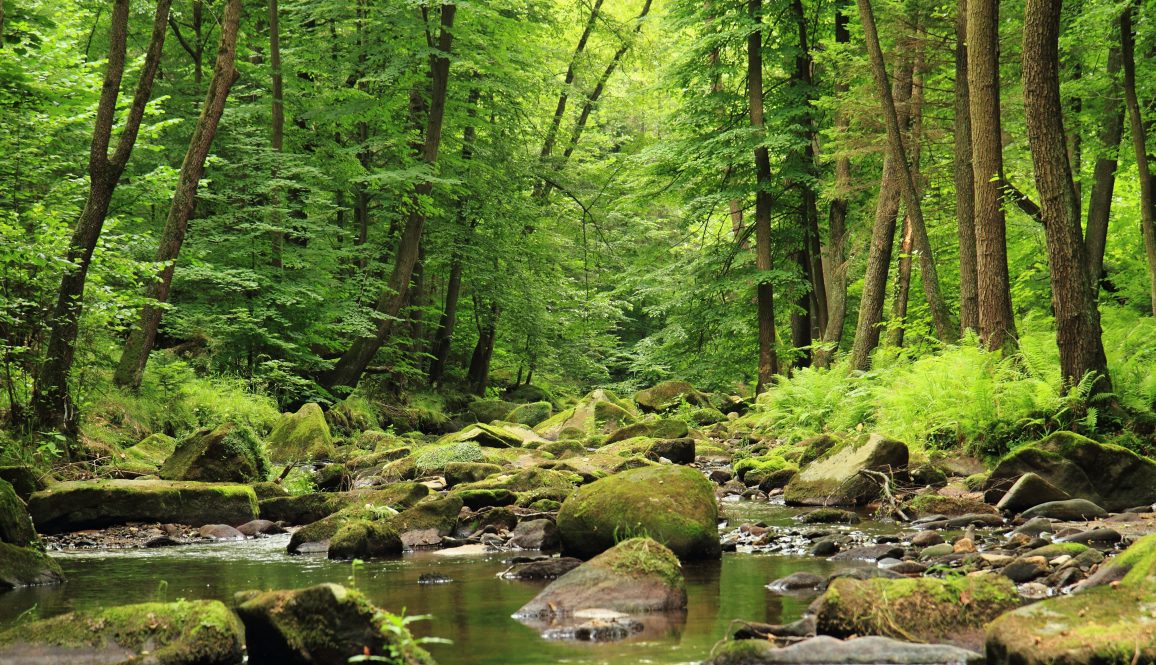When working to find solutions for complex problems, it can be easy to focus either too broadly or too narrowly. Oftentimes the answers lie somewhere in the middle.
UConn Department of Natural Resources and the Environment researcher James Knighton and his group are working to connect two fields of research – one with a global focus, the other with a local focus — to overcome a disconnect and improve models used for studying how water moves through the earth’s systems. The study is published in the Journal of Advances in Modeling Earth Systems.
Knighton explains that projections for climate change over the next 50 to 100 years rely on complex models called general circulation models or earth systems models.
“In those models, people try to simulate the flow of the atmosphere, the flow of the ocean, water exchanges with the continents, how that water moves as freshwater out to the ocean, and how a significant portion of it moves back to the atmosphere. About half of all rain that falls on land goes back to the atmosphere directly and most of that through plants.”
This is where the first problem arises, says Knighton; since it’s difficult to simulate the nuances of how plants influence the flow of moisture through the system, plants present a significant source of uncertainty.
The current modeling approach simply organizes plants into functional groups by region. For instance, in the Eastern United States, the forests are a complex mixture of coniferous and deciduous species, but the whole area is organized into one functional group, despite the plants that make up these forests having different hydrological qualities from species to species (see sidebar).
“Across the whole world, there are around 30 to 40 functional types, so every patch of vegetation on the planet has to fit into one of these coarse groups, and whatever the parameters are for that group, that’s what is used to simulate water flux,” Knighton says. “Everything is assigned one value and that’s that.”
Models estimate many things about the functional types, from “conductance,” or how fast water moves through the plants, to how deep the roots of the whole function group descend, and therefore, how readily they can access groundwater.
In contrast to the broad, whole-earth-system approach, Knighton’s group sought to refine this approach with data from researchers in the field who collect information on what the modelers estimate.
“They’re not taking a global view, rather, they go into a forest that contains tens of thousands of trees, and select, maybe ten to sample to represent what was going on over those 10,000 trees,” says Knighton.
Knighton’s team also wanted to address the fact that field researchers encounter uncertainty in choosing which trees to sample from when there are so many options. Which trees will give the most representative data?
“We took a large-scale hydrologic model and showed that you could derive viable plant traits for an individual species by using these small-scale measurements on individual trees,” he says.
They took water samples from the trunks of 30 different trees, called xylem water, and also sampled soils near the trees to analyze the chemistry of the water. With these data, the researchers traced the water’s path through the ecosystem.
“We can get decent estimates of how deep the roots are,” Knighton says. “For example, if the chemical signature in the tree matches the signature at one meter deep, that’s probably where the roots were drawing water.”
The researchers then used these results to calibrate one of the hydrological models, and Knighton says they were able to estimate and validate many parameters including how fast the water moves up through the plant, how much light the canopy intercepts, and how deep the roots reach.
“Field researchers have been taking these measurements for decades, but no one’s ever attempted to use them to pin down what’s going on with plants in these big-scale models,” says Knighton, who hopes this research illustrates a potential path out of the plant functional group dilemma and help remove some of the uncertainty that arises with the overgeneralizations the models currently rely on.
“One of the problems people always point to is that it isn’t feasible to collect data to include individual species, and we’re saying no, much isotopic data already exists for many tree species, and you can use it in this viable way. There are thousands of species that have had these measurements taken by field researchers.”
The team also found that the model was validated more effectively using data from younger trees, an important detail to help inform future field experiments.
“Smaller and younger trees gave a better overall fit in the model so when we go back to do our field research, we might not sample the rare 100-year-old tree, we might instead focus on the much more common 30 to 40-year-old trees. The smaller trees let us match everything in the model simultaneously whereas, with the larger trees, there was always a conflict.”
The team chose to focus on hemlock because the species is critical, as these trees inhabit river and wetland areas throughout the northeast. They are also threatened by an invasive insect called the hemlock woolly adelgid.
“If you hike through UConn Forest along the Fenton River, you’ll be surrounded by hemlock trees, and if you move up the slope a little bit, there are oak and maple everywhere so they’re in a very specifically important hydrologic area right along the banks of the stream. Climate change is pushing the woolly adelgid insect further and further north.”
This is troubling news considering mounting evidence that losing the hemlock will fundamentally change the region’s hydrology, says Knighton:
“When we conducted this experiment, we didn’t see any of the woolly adelgid insects, but now they are on most hemlock trees along the river. We specifically focused on the hemlock, not just to do this study of modeling, but because we wanted to know what the hydrologic function of these plants is, so we have a baseline for studying the future if they’re lost.”
This highlights another issue with the functional groups, in that they make the models inflexible and unable to simulate some of the impacts of climate change, like what happens when we rapidly lose a single species such as the hemlock which plays a unique role within the ecosystem.
“Another point of the paper was to show that the issue of not representing all species explicitly is a problem because we are likely to see these shifts in forest species composition. We can’t just say the only thing that’s going to change is air temperature. We must acknowledge that there will be ecological changes that will feed back to water and climate.”



